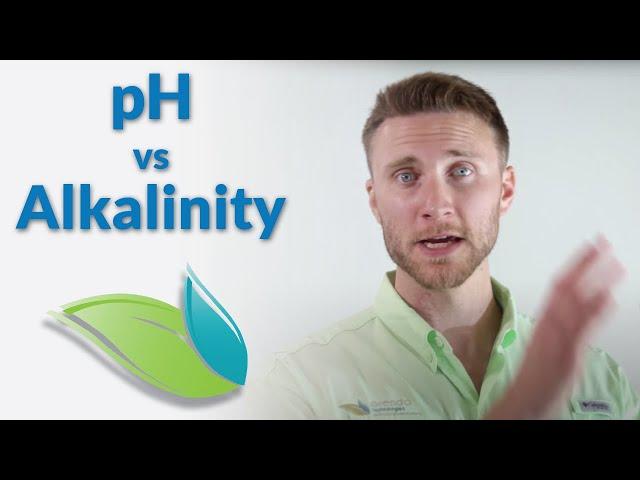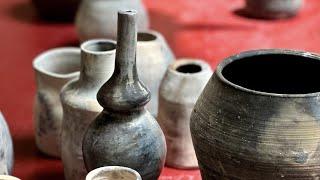
pH vs. Total Alkalinity in Water Chemistry | Orenda Whiteboard
What is the difference between pH and alkalinity?
https://blog.orendatech.com/total-alkalinity-role-water-chemistry
Many of us in aquatics confuse total alkalinity and pH. It’s understandable, given how similar the words “alkaline” and “alkalinity” are. Indeed, alkalinity and pH are related (pH determines the concentration of Hydrogen, which determines the % of which type of alkalinity you have in water). But pH and alkalinity are not the same.
What is pH?
pH stands for potenz Hydrogen, or more commonly called “power of Hydrogen.” It is the measure of the concentration of hydrogen ions in a solution. We measure how acidic or basic (also called alkaline) substances are by using the pH scale.
pH = -log[H+]. It is a negative logarithm of Hydrogen concentration on a scale of 0-14. Every whole number is 10x the next whole number. 7 is perfectly neutral water. For example, something with a pH of 6 is 10x more acidic than pure water. Something with a pH of 5 is 10 times more acidic than 6, which means it’s 100 times more acidic than pure water (10×10=100).
Trichlor, a popular stabilized chlorine used in outdoor swimming pools, has a pH of 2.8. For easier math, let’s just round it to 3.0. How acidic is 3.0 pH Trichlor compared to 7.0 pH pure water? Let’s figure it out.
(7.0 – 3.0) = 4.0
Logarithmic scale means 10^4, or 10x10x10x10 = 10,000
Trichlor is 10,000x more acidic than pure water.
The role of pH in water chemistry
Managing pH is a critical component of maintaining healthy water chemistry. It is so important because pH is a driving factor in the Langelier Saturation Index (LSI), and also because pH determines how effective chlorine will be. The lower the pH, the stronger chlorine will be. Lower pH means a higher % of the strong form of chlorine, Hypochlorous Acid (HOCl), compared to the weak Hypochlorite Ion (OCl-).
Low pH can cause damage to pool liners and etching of plaster; corrosion of metal components in and around the pool; skin and eye damage, as well as general patron discomfort; and a reduction of total alkalinity. On the other hand, high pH water can cause scale formation; metal stains; cloudy water; poor efficiency of chlorine, and also can cause skin and eye irritation. Just stay within the 7.4-7.6 range to avoid those problems. https://blog.orendatech.com/langelier-saturation-index
What is Total Alkalinity?
Total alkalinity is a measurement of all alkaline substances dissolved in the water. These substances are primarily bicarbonates, carbonates and hydroxides, and some others (like cyanurate alkalinity). These alkaline substances buffer pH in the water by either taking or giving a hydrogen ion. In other words, total alkalinity is a measurement of the water’s ability to resist change in pH.
Alkalinity, A Beginners Guide: https://blog.orendatech.com/what-is-alkalinity
Carbonate Alkalinity vs. Total Alkalinity: https://blog.orendatech.com/total-vs-carbonate-alkalinity
Total alkalinity is measured in parts-per-million (ppm), and the ideal range is from 80-120ppm.
The Role of Total Alkalinity in Pool Chemistry
If you’re a pool operator, you probably already know that pH can fluctuate up and down. Another way to think of total alkalinity’s role is that it neutralizes acid.
You could have a ton of 8.3pH Sodium Bicarb floating around in the water, and have the same pH as if you added a smaller amount of 13.0pH soda ash. But the total alkalinity would be higher for the Sodium Bicarb, because there’s simply more of it in the water.
https://blog.orendatech.com/total-alkalinity-role-water-chemistry
Many of us in aquatics confuse total alkalinity and pH. It’s understandable, given how similar the words “alkaline” and “alkalinity” are. Indeed, alkalinity and pH are related (pH determines the concentration of Hydrogen, which determines the % of which type of alkalinity you have in water). But pH and alkalinity are not the same.
What is pH?
pH stands for potenz Hydrogen, or more commonly called “power of Hydrogen.” It is the measure of the concentration of hydrogen ions in a solution. We measure how acidic or basic (also called alkaline) substances are by using the pH scale.
pH = -log[H+]. It is a negative logarithm of Hydrogen concentration on a scale of 0-14. Every whole number is 10x the next whole number. 7 is perfectly neutral water. For example, something with a pH of 6 is 10x more acidic than pure water. Something with a pH of 5 is 10 times more acidic than 6, which means it’s 100 times more acidic than pure water (10×10=100).
Trichlor, a popular stabilized chlorine used in outdoor swimming pools, has a pH of 2.8. For easier math, let’s just round it to 3.0. How acidic is 3.0 pH Trichlor compared to 7.0 pH pure water? Let’s figure it out.
(7.0 – 3.0) = 4.0
Logarithmic scale means 10^4, or 10x10x10x10 = 10,000
Trichlor is 10,000x more acidic than pure water.
The role of pH in water chemistry
Managing pH is a critical component of maintaining healthy water chemistry. It is so important because pH is a driving factor in the Langelier Saturation Index (LSI), and also because pH determines how effective chlorine will be. The lower the pH, the stronger chlorine will be. Lower pH means a higher % of the strong form of chlorine, Hypochlorous Acid (HOCl), compared to the weak Hypochlorite Ion (OCl-).
Low pH can cause damage to pool liners and etching of plaster; corrosion of metal components in and around the pool; skin and eye damage, as well as general patron discomfort; and a reduction of total alkalinity. On the other hand, high pH water can cause scale formation; metal stains; cloudy water; poor efficiency of chlorine, and also can cause skin and eye irritation. Just stay within the 7.4-7.6 range to avoid those problems. https://blog.orendatech.com/langelier-saturation-index
What is Total Alkalinity?
Total alkalinity is a measurement of all alkaline substances dissolved in the water. These substances are primarily bicarbonates, carbonates and hydroxides, and some others (like cyanurate alkalinity). These alkaline substances buffer pH in the water by either taking or giving a hydrogen ion. In other words, total alkalinity is a measurement of the water’s ability to resist change in pH.
Alkalinity, A Beginners Guide: https://blog.orendatech.com/what-is-alkalinity
Carbonate Alkalinity vs. Total Alkalinity: https://blog.orendatech.com/total-vs-carbonate-alkalinity
Total alkalinity is measured in parts-per-million (ppm), and the ideal range is from 80-120ppm.
The Role of Total Alkalinity in Pool Chemistry
If you’re a pool operator, you probably already know that pH can fluctuate up and down. Another way to think of total alkalinity’s role is that it neutralizes acid.
You could have a ton of 8.3pH Sodium Bicarb floating around in the water, and have the same pH as if you added a smaller amount of 13.0pH soda ash. But the total alkalinity would be higher for the Sodium Bicarb, because there’s simply more of it in the water.
Тэги:
#orenda #clean_pool #green_pool #natural_pool_chemical #pool_chemicals #natural_pool_chemistry #pH #pool_pH #total_alkalinity #pool_alkalinity #carbonate_alkalinity #carbonate_alkalinity_vs._total_alkalinity #what_is_carbonate_alkalinity? #alkaline_vs._alkalinity #alkaline #bicarbonate #carbonate #hydroxide #pH_scale #pH_of_chlorineКомментарии:
pH vs. Total Alkalinity in Water Chemistry | Orenda Whiteboard
Orenda Technologies
Chatnoir vibes
Lalaamor07
Pit Firing
Slow Pottery
3 Tips for THE ONI
Kyto
Kannada Devotional Songs
Sri Thagyamma Devi
Dost ko maine dusman jana sad songs Md Aziz Jeetendra Sanjay Dautta (Mahanta
Romantic Music Isarul
Panayam kay AFP spokesperson Col. Francel Margareth Padilla
PTV Philippines
【クコ×ステラ】ビバハピ / Mitchie M【花騎士 - MMD】
Pest Xin


























